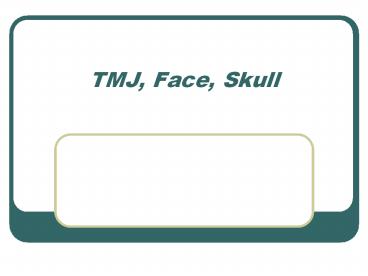TMJ, Face, Skull PowerPoint PPT Presentation
1 / 61
Title: TMJ, Face, Skull
1
TMJ, Face, Skull
2
TMJ
- Mandibular fossa of temporal bone with condyle of
mandible - Incongruent surfaces
- Two joint cavities with articular disc interposed
- Lower cavity hinge joint
- Upper joint gliding
3
TMJ
4
TMJ
5
Mandible
6
Mandible
7
TMJ
- Capsule
- Surrounds the joint
- Encloses the disc
- Attaches above the margins of the mandibular
fossa - To the neck of the mandible
- Inner aspect of capsule attaches to disc
- Above disc capsule loose
- Below disc - taut
8
TMJ Capsule
9
TMJ Capsule
10
TMJ
- Ligaments
- Lateral ligament - AKA TMJ ligament
- From zygomatic bone to run inferiorly and
posteriorly to blend with the joint capsule to
attach to lateral and posterior parts of the neck
of the mandible - Sphenomandibular
- Strong thin flat band lying on medial aspect of
the joint - Passes inferiorly and forwards from the spine of
the sphenoid to the lingula - Stylomandibular
- Extends from the apex of the styloid process to
the lower part of the posterior border of the
ramus of the mandible, near the angle
11
TMJ Capsule
12
TMJ
- Innervated by CN V, Mandibular branch
- Movements
- Elevation, depression, retraction, protraction,
side to side - Elevation and depression involves the hinge like
rotation of the condyle against the disc in the
lower compartment - Protraction and retraction actions whereby the
condyle and disc move as one unit against the
mandibular fossa. In protraction the condyle and
disc glide forwards so that the condyle rides on
the articular eminence retraction opposite
13
CN V Trigeminal
14
TMJ Motions
15
TMJ Motions
16
TMJ
- Side to side grinding movements
- Mandible is alternately protracted and retracted
with the two sides moving in opposite directions
so that one side is protracted while the other is
retracted - Actions combined with elevation and depression,
rhythmically and alternately
17
Muscles of Mastication
- Masseter
- Temporalis
- Lateral pterygoid
- Medial pterygoid
- All innervated by CNV
- Opening of jaw (depression) primarily passive or
gravity assist
18
Masseter
19
Temporalis
20
Pterygoids
21
Pterygoids
22
Pterygoids
23
Nerve Supply to Face
- Sensory by three divisions of CN V opthalmic,
maxillary, mandibular - Innervation of muscles of facial carried out by
CN VII the Facial Nerve - Origin, branches, motor functions, sensory
functions, parasympatheric functions
24
CN V
25
CN V
26
Sensory to Face
27
Sensory
28
Scalp
- Three Layers
- Outer skin
- Beneath that subcutaneous layer with many
nerves and vessels running through here, binds
skin to inner layer - Galea Aponeurotica AKA epicranial aponeurosis
- Galea attaches to pericranium via loose CT
- This allows scalp to move over the skull
- Most muscles of face attach to skin, this
arrangement allows them to be more mobile.
29
Scalp
30
Scalp
31
CN VII The Facial Nerve
- Motor nerve to muscles of facial expression with
one notable exception - Origin lower pons
- Branches common nerve enters face
- Temporal
- Zygomatic
- Buccal
- Mandibular
- Cervical
32
Motor to Face CNVII
33
CN VII
- Motor Functions
- Muscles of facial expression
- External ear
- Sensory functions
- Ant. 2/3 of tongue
- Soft palate
- Pharynx
- Parasympathetic
- Gland stimulation
34
CN VII
35
Muscles of Facial Expression
- Primary action is to act as either a sphincter or
dilator of the orifices of the face - Facial expression is a by-product
- Orifices
- Lips labia
- Nose nares Nostrils, Septum, Ala, Apex, Root
- Eyelids palpebrae
- External Ear auricle, lobule soft portion
36
Selected Muscles of Facial Expression learn
- Orbicularis Oculi
- Levator Palpebrae Superioris
- O Root of Orbital Cavity
- I Skin of upper eyelid
- A Raises upper eyelid
- N Note Well, Nerve CN III
- Ptosis is a condition of denervation to this
muscle causing drooping of the eyelid, a clinical
symptom indicating more loss
37
Facial MM
38
Facial MM
39
Facial MM
40
Facial MM
41
Muscles Continued
- Occipitofrontalis
- Corrugator
- Auricular muscles of the ear ant., post., sup.
- Nose
- Nasalis
- Procerus
- Depressor Septi
42
Facial MM
43
Facial MM
44
Ear MM
45
Nose MM
46
Nose MM
47
Muscles
- Mouth
- Depressor anguli oris
- Depressor labii inferior
- Mentalis
- Risorius
- Orbicularis oris
- Buccinator
- Zygomaticus major
- Zygomaticus minor
- Levator labii superioris
- Platysma
48
Platysma
49
Mouth
50
Facial MM
51
Extra Occular Muscles of the Eye
- Muscles that move the eyeball
- Innervated by CN III (most), CN IV (1),CN VI (1)
- Many have an origin from the annulus tendinous, a
common tendon ring attached around the optic
canal - Most attach to the sclera of the eyeball
52
Eye MM
53
Muscles
- Superior Rectus rotates eyeball upward and
medially CN III - Medial Rectus rotates medially (ADD) CN III
- Lateral Rectus rotates eyeball laterally (ABD)
CN VI - Inferior Rectus rotates eyeball downward and
medially CN III
54
Eye MM
55
Eye MM
56
Eye MM
57
Eye MM
58
Muscles
- Superior Oblique rotates eyeball downward and
lateral CN IV - Inferior Oblique rotates eyeball upward and
lateral CN III - Combined motions
- Up and medial sup.rectus
- Up and lateral inferior oblique
- Straight up sup. rectus and inf. oblique
- Straight down inf. rectus and sup. oblique
- Down and medial inferior rectus
- Down and lateral superior oblique
- Lateral Gaze ABD of one eye with ADD of the
other
59
Eye Movements
60
Eye Movments
61
Eye Movements

